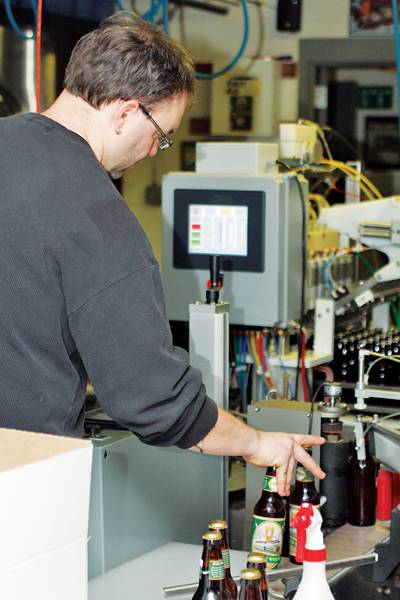Olde Main holds head high

Jeff “Puff” Irvin, head brewer of Olde Main Brewing Co., packages Dinkey Wheat, one of Olde Main’s products. Olde Main is expanding their beer lines. Photo: Shing Kai Chan/Iowa State Daily
January 25, 2009
Olde Main Brewing Co., 316 Main St., Ames’ only microbrewery, has been expanding throughout 2008 and plans to continue expansion in 2009 despite the economic recession. University economists are skeptical whether an expansion will be successful.
The head brewer at Olde Main, Jeff Irvin, said the company is hoping to operate at capacity in the next three or four months in order to justify building another larger facility.
“What we’d like to do is build a production facility off-site where we can pump out some more juice and certainly add more styles to our bottled product,” Irvin said. “Our plan is to be in all 99 counties in Iowa by the end of the year.”
This is an unlikely scenario, said Dave Swenson, associate scientist of economics – agriculture and life sciences.
“They are trying to do this in a year when everybody is cutting back on their spending,” he said.
During a recession, people start cutting back on discretionary purchases. Discretionary purchases are those which may seem unnecessary, such as eating out. Beer is considered part of these purchases and is often associated with going out, parties and fine dining, Swenson said.
“They are trying to move into a new market when people are less inclined to go out,” Swenson said.
Olde Main Brewery has its work cut out for it, particularly because the beer industry is fiercely competitive, he said. The loyalties people have toward beer brands run deep and are often hard to break. As a result, being successful in a new market is hard no matter how the economy looks, Swenson said.
There is some speculation on when the business cycle will pick up again. The timing of a climb in the economy may provide just the boost Olde Main needs to complete its plan.
Peter Orazem, university professor of economics – liberal arts and sciences, said the markets may be rebounding by the time Olde Main’s expansion plan is completed.
The brewery remains very optimistic about the new plan despite the bleak economic situation.
Olde Main started bottling its beer in May of 2008, which is available in over 250 retail bars, restaurants and stores in Iowa.
Every year since its opening, Olde Main has doubled its production. The plans for expansion will allow it to increase production in the future. The current U.S. recession hasn’t affected the brewery’s business thus far.
“Beer is food,” Irvin said. “It’s almost recession proof.”
Irvin, also known as Puff, has worked at the brewing company since its opening in 2003. He has an undergraduate degree in biology from Iowa State and a master’s degree from the master brewers program at the University of California-Davis.
“It’s not about drinking 15 beers. It’s about enjoying the one in your hand,” Irvin said. “There’s an art form to using the system.”
Olde Main has a wide variety of beers on tap.
The brewing process is a combination of chemistry and cooking. Each beer unique to the brewing company has been carefully designed.
“The brewing process is basically taking [the] natural sugars and manipulating them naturally with the natural enzymes that are there, sterilizing it and then feeding it to yeast,” Irvin said. “Yeast, in that beautiful, magical process of fermentation, is going to turn it into ethanol and carbon dioxide.”
The bar has three featured brews, Dinkey Wheat, a Belgian-style wheat ale; Off KILTer, a Scottish ale; and Long Face, an amber ale.
The Dinkey Wheat was “named for the train that used to run from downtown Ames to ISU campus” according to Olde Main’s Web site.
Irvin said he wears a kilt while he brews the Scottish ale “to achieve maximum Scottish feel and tradition.” He is also learning to play the bagpipes.
The brewing process
Main ingredients: Malted barley, yeast, water and hops
Germination: Barley starts germination before being sold to brewers. This process releases enzymes, which break down carbohydrates to simpler sugars. Germination stops when all water is removed from the seed.
Roasting: Barley is roasted, similar to coffee beans. The color is determined by how much the barley kernel is roasted.
The rest: Barley is cracked in half and piped into a vat and mixed with hot water. While enzymes continue to break down the carbohydrates, the “big batch of oatmeal,” as Irvin calls it, is drained and the sugar mixture is pumped into another vessel. This vessel is like a big enclosed pot and heated to a boil. The alcohol concentration of the final product is determined by the sugar percentage of the mixture. The more water that is boiled off, the higher the alcohol percentage. The sugars caramelize after two-and-a-half hours. The mixture is sterilized and hops are added. The bitterness in beer is from the hops. The mixture is cooled to avoid instantly killing the yeast. The mixture is moved to fermenters where one of two strains of yeast is added. Ale comes from one strain. Lager comes from the other strain. These two types account for all the different styles of beer. Ale ferments in two to five days and then is aged for two weeks after that. Lager takes three weeks to ferment and then is aged for four to six weeks. The finished beer is moved to a storage room in tanks. The beer runs directly from the tanks to the tap at the bar upstairs for everyone to enjoy.
















